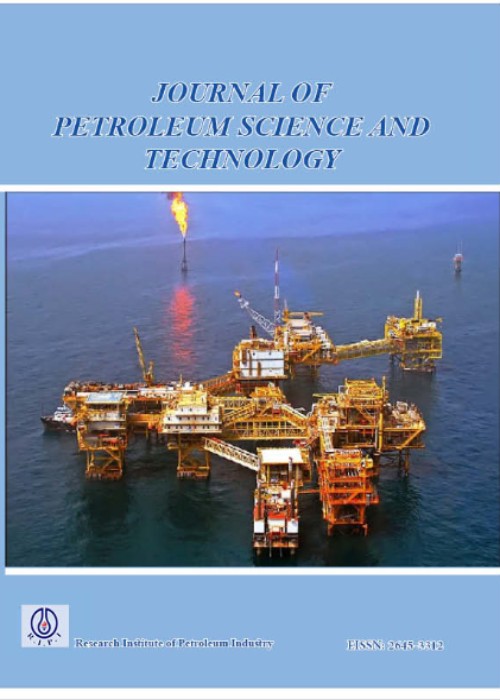Association of the Flow Units with Facies Distribution, Depositional Sequences, and Diagenetic Features: Asmari Formation of the Cheshmeh-Khush Oil Field, SW Iran
Author(s):
Abstract:
The Oligo-miocene Asmari formation is one of the most important hydrocarbon reservoirs in the southwest of Iran. In order to evaluate reservoir quality and the factors controlling reservoir properties, detailed geological and petrophysical studies were carried out on 242 m of core samples from Asmari reservoir. This study is a part of a larger project that examines depositional history and reservoir properties of the Asmari formation in the Cheshmeh-Khush field. Macroscopic and microscopic studies resulted in the determination of 5 shallow marine carbonate facies (from proximal open marine to tidal setting) and also 5 silisiclastic lithofacies (including channel, barrier, tidal, and shoreface sandstones). Based on the integrated results from sedimentological and paleontological studies, Sr isotopes dating, gamma-ray logs, and seismic data analysis, 5 depositional sequences with constituent system tracts were distinguished.
In this research, the reservoir characterization of the Asmari reservoir were carried out through the integration of geological and petrophysical properties. In the first step, 21 hydraulic flow units (HFU or FU) were identified and then, to achieve better lateral correlation and modeling, HFUs were merged to 17.
The results from this study showed different behaviors of the silisiclastic and carbonate facies next to the fluid flow. The findings of this study indicate that the lateral and vertical distribution of channel-filled sandstones (such as units 2 and 8) are strongly controlled by the geometry of depositional facies. Thus, the correlation and modeling of flow units, solely on the basis of lithology and thickness, and regardless of facies and its geometry, will cause different facies (such as coastal and channel-filled sandstones) with different geometry, and reservoir quality are placed incorrectly in a single flow unit.
In the carbonate parts of Asmari formation, the effect of diagenetic processes on reservoir quality is much higher than the facies. Hence, the LST limestones of unit 17, as a result of calcite cementation, were changed to a thick, distinct, correlatable, and barrier unit. On the other hand, dolomitic intervals that have not been affected by anhydrite cementation have formed porous and permeable carbonate reservoir units (such as units 18 and 21).
In this research, the reservoir characterization of the Asmari reservoir were carried out through the integration of geological and petrophysical properties. In the first step, 21 hydraulic flow units (HFU or FU) were identified and then, to achieve better lateral correlation and modeling, HFUs were merged to 17.
The results from this study showed different behaviors of the silisiclastic and carbonate facies next to the fluid flow. The findings of this study indicate that the lateral and vertical distribution of channel-filled sandstones (such as units 2 and 8) are strongly controlled by the geometry of depositional facies. Thus, the correlation and modeling of flow units, solely on the basis of lithology and thickness, and regardless of facies and its geometry, will cause different facies (such as coastal and channel-filled sandstones) with different geometry, and reservoir quality are placed incorrectly in a single flow unit.
In the carbonate parts of Asmari formation, the effect of diagenetic processes on reservoir quality is much higher than the facies. Hence, the LST limestones of unit 17, as a result of calcite cementation, were changed to a thick, distinct, correlatable, and barrier unit. On the other hand, dolomitic intervals that have not been affected by anhydrite cementation have formed porous and permeable carbonate reservoir units (such as units 18 and 21).
Keywords:
Language:
English
Published:
Journal of Petroleum Science and Technology, Volume:7 Issue: 3, Autumn 2017
Pages:
47 to 66
magiran.com/p1750304
دانلود و مطالعه متن این مقاله با یکی از روشهای زیر امکان پذیر است:
اشتراک شخصی
با عضویت و پرداخت آنلاین حق اشتراک یکساله به مبلغ 1,390,000ريال میتوانید 70 عنوان مطلب دانلود کنید!
اشتراک سازمانی
به کتابخانه دانشگاه یا محل کار خود پیشنهاد کنید تا اشتراک سازمانی این پایگاه را برای دسترسی نامحدود همه کاربران به متن مطالب تهیه نمایند!
توجه!
- حق عضویت دریافتی صرف حمایت از نشریات عضو و نگهداری، تکمیل و توسعه مگیران میشود.
- پرداخت حق اشتراک و دانلود مقالات اجازه بازنشر آن در سایر رسانههای چاپی و دیجیتال را به کاربر نمیدهد.
In order to view content subscription is required
Personal subscription
Subscribe magiran.com for 70 € euros via PayPal and download 70 articles during a year.
Organization subscription
Please contact us to subscribe your university or library for unlimited access!


